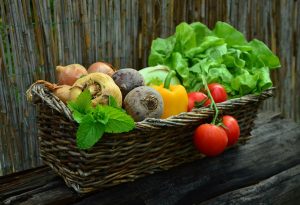Since 2004, The Environmental Working Group (EWG) has released an annual Shopper’s Guide to Pesticides in Produce, a.k.a, The Dirty Dozen.
The nonprofit organization uses data from the Food and Drug Administration (FDA) and the U.S. Department of Agriculture (USDA) to account for contamination in nonorganic produce. The FDA and USDA analyzed 47,510 samples of 46 fruits and vegetables, finding that all of them tested positive for trace amounts of 254 pesticides — 209 of which were on the Dirty Dozen list. “But for items on the Dirty Dozen, a whopping 95% of samples contain pesticides.”
Among those pesticides, the fungicides fludioxonil, pyraclostrobin, boscalid, and pyrimethanil represent “four of the five most frequently detected chemicals.” And two of these, fludioxonil and pyrimethanil, have “the highest average concentrations of any pesticides found on the Dirty Dozen.” Both are known to be health threats, with fludioxonil having the “capacity to disrupt hepatic, endocrine, and neurological systems,” per a study out of the University of Wisconsin-Madison. While pyrimethanil, which was predominantly found on pears, is associated with thyroid disruption and the blocking of androgen receptors.
At the top of this year’s list are strawberries and spinach, both of which were in the top spots last year. The last four — bell and hot peppers, cherries, blueberries, and green beans – held steady at numbers 9–12. Grapes, however, jumped to No. 4 this year from No. 8 in 2023. Beware the green bean: EWG found that organophosphate insecticide acephate, a neurotoxin banned 13 years ago, was found in 6% of the vegetable.
EWG also releases an annual Clean Fifteen list, which ranks fruits and vegetables “with very low or no pesticide residues.” Nearly 65% of the sampled produce in this year’s list “had no detectable pesticide residues.” Leading the list are avocados, sweet corn, pineapple, onions, and papaya.
The Dirty Dozen
The Clean Fifteen
- Strawberries
- Spinach
- Kale, collard, and mustard greens
- Grapes
- Peaches
- Pears
- Nectarines
- Apples
- Bell and hot peppers
- Cherries
- Blueberries
- Green beans
- Avocados
- Sweet corn
- Pineapple
- Onions
- Papaya
- Sweet peas (frozen)
- Asparagus
- Honeydew melons
- Kiwi
- Cabbages
- Watermelon
- Mushrooms
- Mangoes
- Sweet potatoes
- Carrots
WHAT TO DO?
For toxins on the exterior, we use produce cleaners on any and all fresh produce prior to storage and consumption. You can add a teaspoon of baking soda to purified water in a spray bottle and spray the produce to clear anything from the field to your door. Toxins from handling, plastic bags and trays and the sprays in the grocery stores. To avoid toxins from the soil, we purchase organic.
Here is to healthy doing and choosing!
Photo credit: Image by congerdesign from Pixabay

